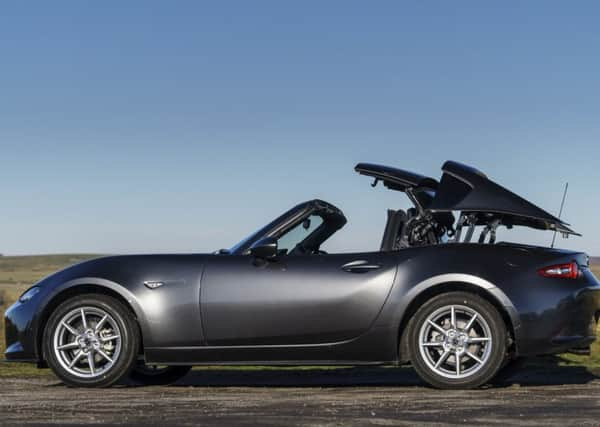Review: Mazda MX-5 RF


Now there’s a variation on the MX-5, the RF, which stands for Retractable Fastback. In some clever folding, the steel, aluminium and composite structure cavorts, storing the top of the roof and rear window out of sight and leaving the side panels in place. Luggage space is unaltered. It looks a perfect development of the two-seater. The conversion adds 45kg to the weight and in theory this higher centre of gravity will cause more body roll. You can discuss that over nibbles in the Smallbore & Sporran Bar. Phissiks and kinetic energy, innit. And choose between Soul Red and Machine Grey paint. But seen from the pub car park, pavement edge or in our case on a rollicking drive over Mazda’s Dartmoor launch pad this car looks ace.
Extra soundproofing is fitted and the suspension and steering re-set to give a more refined ride to fit with the aspirations of the stylists. Body rigidity remains stiff and from memory the RF feels just as exciting as the soft-top model. Jeremy Thompson, who grew up on Dartmoor and is now MD of Mazda UK, expects the RF to take 75 per cent of MX-5 sales.
Advertisement
Hide AdAdvertisement
Hide AdIt costs £2,000 more than the soft top, with the 129bhp 1.5 SE-L Nav opening the book at £22,195. The Sport Nav model is £24,795. The 158bhp 2.0 SE-L Nav is £23,095 and the Sport Nav is £25,695. The latter is available with automatic gears at £27,095.
Deliveries begin in March for the 2.0 model, with the 1.5 engine joining in May. We tried each version with six-speed manual gearboxes. The 1.5 felt as punchy as the 2.0 but on paper it falls short in performance and, for its extra £900 the 2.0 RF has a limited slip differential (useful in snow as well as for hustling through bends), larger 17-inch gunmetal finish alloys and a “piano” black finish on the door mirror casings on the SE-L Nav. Bilstein dampers, a strut brace under the bonnet, bright alloys and body-coloured mirror casings are added on the 2.0 Sport Nav version. It’s no larger inside than the Roadster, a deterrent to the well-upholstered driver who will find the fully open soft-top car easier to get in and out of. Cabin layout is the same – a locker in the rear bulkhead, two movable cup holders, no door pockets. All versions have climate control, LED headlamps, cruise control, a touch screen, navigation, DAB radio, Bluetooth. Sport Nav adds heated black leather seats, auto lights and wipers and dimming mirror, adaptive front lights, keyless entry, rear parking sensor and Bose audio – though you’ll have to keep the speed down to appreciate the quality.
Special paint finishes cost from £550. A safety pack of automatic headlamp dipping, blind spot alert and rear crossing traffic warning is a reasonable £400 but is only available with the 2.0 Sport Nav – a curious decision. As is the confusing swap around of mirror casing colours. Viz, the 1.6 SE-L Nav has the body colour door mirrors specced on the more expensive 2.0 Sport Nav while the 1.5 Sport Nav gets the piano black mirror pods fitted to the 2.0 SE-L Nav. I wonder who came up with that curious bit of cosmetic shuffling?
This car will sell on its looks. There’s nothing like it anywhere near these prices, and while you can have fastback two-seaters the only one with an opening section which comes to mind is the £90,240 Porsche 911 Targa 4. You can have almost as much legal fun in the Mazda.
Soft-top or fastback? The soft top is cheaper and you can get an entry 1.5 SE model for £18,495. It becomes a fully open car whereas the RF is always cowled at the back. With the roof open the RF remains snug even on an early morning winter drive. At motorway speeds with the roof open the wind hammers noisily on the cowl structure, louder than you get on the roadster.
In nasty weather you’ll probably prefer the RF’s cocooned cosiness. The roof opens rapidly so you can dip in and out of bright spells. It’s all very usable, enjoyable, accessible, exciting too.
Fiat is rumoured to be bringing out a 124 fixed-roof coupe – discounted by a Fiat spokeswoman.
Verdict: Yes.